- Home
- Michael Crichton
Delos 1 - Westworld Page 2
Delos 1 - Westworld Read online
Page 2
His greatest problem was the sequence where his face was burned with acid. Frank Griffith had experimented with various techniques and finally settled on a mixture of makeup and Alka-Seltzer, which fizzed and bubbled when water touched it. That left a final problem: smoke. We had done a test with an extra who had small tubes of smoke glued to his face in various, places. Once the smoke began to be squirted out, the extra coughed and cried and sputtered in a comical fashion. The smoke was enormously irritating to nose and eyes.
Still, it was our best solution, if Yul could avoid coughing. He had an upset stomach that day, and had taken Alka-Seltzer for it; as the makeup was applied and the plastic smoke tubes attached around his face, we joked that he had Alka-Seltzer inside and outside.
We did the sequence once—water in the face, and then smoke pumped through tubing—and it worked all right, but it happened too fast. Yul said he could do it slower, and he did the second time around. Somehow we got the shot, but it was a remarkable effort on his part. As soon as I yelled “Cut!” he exploded in an attack of coughing.
The rapid work pace built an extraordinary spirit of camaraderie. The pettiness and temper tantrums which are a predictable part of film work simply didn’t exist, for the most part. Dailies were a sort of ritual. Everyone attended them: actors, crew, everyone. I worried that this would invite ego flare-ups and grumbling, but that never happened. The actors were generous with one another, and the crew helped one another with problems. Nobody was fired during the course of production, which is a rare thing in itself.
We were moving so fast and taking so many risks that we passed the point of foolhardiness and found a certain exhilaration in the work pattern. It was insane to be functioning this way. Each day’s work was impossible in the allotted time. We knew it, and so did the studio—they often thought we were falsifying our reports at the end of each day. We made them more comfortable by not showing them all the shot footage every day. We would look at all of it; then Dave Bretherton, the editor, would pull most of it before the executives saw dailies two hours later.
As director, I was camera-cutting. This means I would never shoot a whole scene from a single angle. I’d shoot part of a scene from one angle; part from another angle, with little or no overlap. It was the fastest way to work, but also the riskiest. If the scene didn’t work as shot, I had no extra footage to play with.
I was also picking certain sequences to dwell on, and shooting the others quickly. I knew I could not shoot the whole film well in the thirty days I had been given, so I picked the key scenes and concentrated on them. Hie rest of the scenes were plainly shot in haste, with the hope that the audience would forgive me later.
It wasn’t an ideal situation. But I had known that, going in, and so had everyone else. We made the best film we could in the time we had, and we kept our fingers crossed.
Two weeks after shooting, I saw the assembled film for the first time. It was horrible. It was boring, contrived, self-indulgent and slack. I left the projection room in silent depression. All of our energy and enthusiasm had been wasted on a piece of silly garbage.
Dave Bretherton (David Bretherton won an Oscar in 1973 for Cabaret.) was the only person in good spirits. He cheered me up enough to start editing. We went sequence by sequence, changing timing, replacing shots, adding and dropping things within the narrow limits that were possible with the minimal footage I’d shot. The picture slowly improved. After a month, I thought we might have something decent after all.
We ran the film for the MGM executives. A few executives liked it, but the general feeling was that it was a disaster. However, there was no talk of taking the picture away from me—everyone knew that I had camera-cut, and there was no spare film to play with. And the MGM management did agree to some additional shooting. I had once considered beginning the film with a TV commercial, and this idea was taken up. There was a writers’ strike at the time, so the commercial was written by Steve Frankfurt, a New York adman.
The executives saw the film again, a month later. They felt that it was improved, but still a lousy picture. In any case, we’d all know in two weeks, when the film was previewed before an audience.
I had plenty to worry about until then. The computer-generated footage was coming in, far behind schedule. John Whitney had found the process unexpectedly time consuming—it took eight hours to produce ten seconds of film. There were intricate problems with color and contrast balance. We were still doing a lot of testing. On the other hand, we were pleased with the general effect.
Fred Karlin was modifying his score, but nobody knew how it was being changed. I heard it for the first time when we did a temporary mix of dialogue, sound effects and music. I thought the new score was terrific. We got the last of our computer footage, and were ready for the preview.
Metro made no bones about the preview. There would be only one, at the studio, with a selected audience of “regular people,” no movie people. If the reaction was good, MGM would release the film carefully; if the reaction was unfavorable, they’d dump it.
The critical question was how many viewers would call the picture either “excellent” or “good” on the preview cards. Unless we had a seventy-five-percent response in those categories, we were in trouble. Some executives thought we might do better, perhaps as high as eighty or even eight-five percent. Other executives believed the picture was so lame that they didn’t even bother to attend the screening.
The picture began. There was a lot of coughing and shuffling; the laughs didn’t work and came in the wrong places. I sank lower in my seat. The executives were right I had spent a year on this movie and everybody hated it It was an utter disaster.
Then at the end there were screams and applause and when the cards came back, we had a ninety-five-percent rating, the highest anybody at the studio could remember. People were slapping me on the back and saying they’d known it all along. I went out and got very drunk.
The screenplay, reprinted here, is not the original script. Many changes were made from the first version, over a period of months. The following script is the version I had two days before shooting began.
At that time, MGM cut the schedule by three days. I refused to shoot the script as written, and responded by cutting three days of work. The deleted scenes included the salesroom sequences and the bank robbery.
Several other changes occurred in the course of shooting. Principally, the ending was changed. We deleted the final fight between Martin and the gunslinger. We tried it, but it seemed stagey and foolish, so we elected to drop it entirely. I had liked the idea of a complex machine being destroyed by a simple machine—the rack—but otherwise I didn’t miss the lost sequence.
The opening is also changed. We were unable to get convincing model footage of the hovercraft, and so could not play the sequence with full-screen model shots. We had to use TV images. That was a post-production situation and is, by any standard, a compromise.
Still, a film is an exercise in what is possible. I am satisfied that we arrived at the best solutions to the problems we faced, given the available options. For the most part audiences don’t care about those problems, alternatives, or solutions. And they shouldn’t.
Westworld was not intended to be profound. Neither was it intended to be stupid, but our clear goal was entertainment. I like to think that audiences have fun with this film. We had fun making it.
Michael Crichton
Los Angeles
October 13, 1973
Run opening credits on black screen.
Desolate whine of wind over.
FADE IN ON:
A desert landscape at dawn, all muted grays. The desert stretches for miles with no sign of life, and no sound except for the whine of the wind. Then we hear a new, superimposed whine. It is so faint at first that we are not sure we hear it at all. But it builds with astonishing rapidity.
And then from the far distance a silver shape streaks toward us and past us—we’ve hardly seen it.
; CUT TO:
An angle down on the silver shape, as we shoot forward across the desert at extraordinary speed. The roofline in lower frame is streamlined, mechanical. We are zooming at 300 miles an hour. The engine scream is very loud.
CUT TO:
A panning shot of the silver shape. It is a hovercraft, bulletlike, riding on a cushion of air, propelled forward by a howling jet.
CUT TO:
Inside the hovercraft cockpit. The pilot is a foreground silhouette. Through the window the desert rushes up toward us. We skim over sand dunes, rock outcroppings, low ridges. The jet noise is more muted. Crackle of radio communication back and forth.
CUT TO:
Inside the hovercraft passenger section. It looks rather like the interior of a modern jet aircraft. Twenty passengers are there, in a loungelike atmosphere. We gather from their dress and demeanor that they are wealthy, cosmopolitan, and somewhat jaded. The jet sound is very quiet here.
A stewardess serves drinks. The camera follows her to Blane and Martin. Martin is talking. He is in his early to middle thirties, attractive and earnest. In contrast, his companion, Blane, is a little older, a little more assured—and at the moment obviously bored by Martin’s speech. He stares out the window.
MARTIN: I’m not worried at all, I’m just curious. How much do they weigh?
BLANE (shrugging): Three or four pounds.
MARTIN: That’s pretty heavy . . . Do they have much of a kick?
BLANE: It’s not bad.
MARTIN: Well, I never fired a Colt .45 before . . . What about that thing where you go like this (makes fanning motion with flat of his hand, rapidly) over the gun.
BLANE: Fanning.
MARTIN: Yeah.
BLANE: What about it?
MARTIN: Is that hard to do?
BLANE: No.
MARTIN: Now when they give you the gunbelt, does it have those strings to tie around your legs?
BLANE: If that’s the kind you want.
MARTIN: That’s the kind I want. I think it’s probably better for quick draws, you know.
BLANE: It all depends.
MARTIN: Well, it seems to me that most of the gunfighters tie their holsters to their legs with those strings, for quicker draws. What kind of gunbelt did you have the last time?
BLANE: I had one without strings.
MARTIN: And you could draw fast?
BLANE: Yeah.
MARTIN: Then maybe it doesn’t matter, after all . . . (long silence) But the guns that they give you are real guns?
BLANE (nodding): Real guns.
MARTIN: That’s incredible.
There is an electronic pinging. Martin looks questioningly at Blane.
VOICE OVER: The orientation on the resort will now begin. Please put on your earphones.
Martin puts on his earphones.
MARTIN: Don’t you want to listen?
BLANE: I heard it the last time.
Martin nods. Blane stares out the window. Move in on Martin’s face.
RECORDED VOICE (Over): . . . consists of three separate resort areas, each with its own special appeal; Whichever resort you have chosen, we are sure you will have a fascinating and rewarding stay here.
CUT TO:
The front of the cabin and the viewing screen. The present slide shows an overhead map of the circular resort, which is divided into three quadrants, colored differently. The slide changes to show a closer view of the blue quadrant.
RECORDED VOICE: Western World is a complete re-creation of the American frontier of 1880. Here it is possible to relive the excitement and stresses of pioneer life to the fullest.
CUT TO:
RECORDED VOICE: Western World is a life of lawless violence, a society of guns and action . . .
Martin smiles as he watches. Blane gives him a sidelong look. Martin’s attention remains directed to the screen.
CUT TO:
A new slide on the screen.
RECORDED VOICE: This is Medieval World, where we have reconstructed thirteenth-century Europe, a world of chivalry and combat, romance and excitement . . .
CUT TO:
Another part of the passenger compartment. We notice a middle-aged man in a business suit sitting next to a middle-aged woman. He nudges her, smiles—he’s obviously going to Medieval World.
RECORDED VOICE: . . . Our teams of engineers have spared no expense in this re-creation, precise to the smallest detail.
CUT TO:
A new slide on the screen.
RECORDED VOICE: Then we have Roman World, a lusty treat for the senses in the setting of delightful, decadent Pompeii. Here the traveler . . .
CUT TO:
The man and woman. Now the woman is smiling; she’s going to Roman World.
RECORDED VOICE: . . . experiences the sensual, relaxed morality that existed at the peak of the Imperial Roman Empire.
The man blinks; he’s not so sure he likes his wife going there.
CUT TO:
Blane and Martin.
RECORDED VOICE: All together, these resorts comprise Delos, the most exciting vacation spot . . .
CUT TO:
The screen showing the three original quadrants.
RECORDED VOICE: . . . in the history of man. Located five hundred miles into the Sahara Desert, Delos is a triumph of man’s mastery over the environment . . .
CUT TO:
The passenger compartment. We see an anal, taut accountant of about forty-five, reserved and bespectacled, ready to jump at shadows, but watching the screen eagerly.
RECORDED VOICE: Completely self-contained, efficient, (Accountant smiles) and highly reliable . . .
CUT TO:
What the pilot sees from the cockpit as the hovercraft makes a left turn and streaks forward into the morning sun. Directly ahead of us, gleaming like a gem, is a huge complex with a large dome. We can’t see much, but we are moving toward it awfully fast.
CUT TO:
The passenger compartment. A stewardess moves down the aisle, giving out little tags to each passenger.
RECORDED VOICE: . . . Hydrophonic tanks, recycled air and water systems, climate control, the whole spectrum of technology has been employed in Delos for the vacationer’s pleasure. Expensive and unusual, Delos is not for everyone, but for those that choose it, it is truly a unique and rewarding . . .
The stewardess stops by Martin and Blane.
STEWARDESS: Mr. Martin. (gives him blue tag) Mr. Blane. (gives him blue tag)
Blane smiles at her; so does Martin, but hesitantly.
The recorded voice continues over:
CUT TO:
The desert, as the hovercraft shoots forward, into the sunrise, toward the resort.
The hovercraft control room. A bank of TV screens show the approaching hovercraft. Fuzzed figures in the foreground guide the craft in; low technical dialogue.
FIRST TECHNICIAN (voice over): We have you on grid five. Over.
HOVERCRAFT PILOT (voice over): Read you as grid five.
SECOND TECHNICIAN (voice over): Conformation grid five, seven-one-seven, nine-three-eight, wind ess Q.
FIRST TECHNICIAN (voice over): Notify ground crews. Standby.
CUT TO:
A bank of switches. A hand flicks several.
CUT TO:
A TV screen showing the hovercraft landing.
CUT TO:
The actual hovercraft landing, sand spitting up.
CUT TO:
A TV screen showing the hovercraft landing from vertical perspective.
CUT TO:
Hovercraft control room. The personnel oversee the lock-up, flicking switches, speaking softly. We never see the people clearly.
FIRST TECHNICIAN (voice over): Locking in now . . .
SECOND TECHNICIAN (voice over): Shutdown two . . . shutdown three . . .
THIRD TECHNICIAN (voice over): Down two . . . down three . . .
FIRST TECHNICIAN (voice over): Nice job, everybody . . .
CUT TO:
&n
bsp; Inside the hovercraft. It is still day, but the hovercraft is on the ground and in the shadow of the dome, and thus the interior looks different. The passengers are getting out of their seats, unbuckling, speaking in a rising hubbub of voices.
The passengers exit to an elevator.
CUT TO:
Inside the elevator. The passengers stand motionless, facing forward as the elevator descends to the basement garage area. A stewardess accompanies them.
CUT TO:
The underground garage area. Three trams stand waiting; yellow, blue, red. The passengers sort themselves out and move apart. Blane and Martin go to their blue tram.
Standing by each tram is a pretty girl in a color-coded uniform with a hand-size computer of some sort. As Blane and Martin board:
GIRL: Name, please?
MARTIN: Peter Martin.
The girl punches a button on the device.
GIRL: Thank you.
BLANE: John Blane.
GIRL: Thank you.
She smiles pleasantly. They get on board. The tram starts up. Martin looks back at the girl.
CUT TO:
What Martin sees: A traveling shot of the girl diminishing as the tram pulls away.

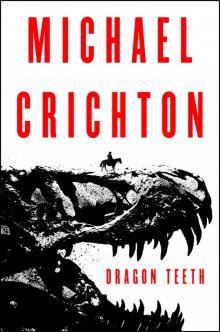 Dragon Teeth
Dragon Teeth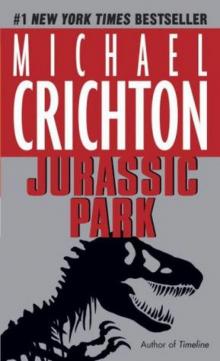 Jurassic Park
Jurassic Park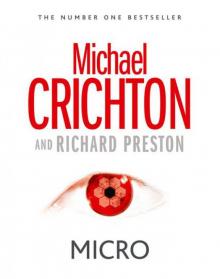 Micro
Micro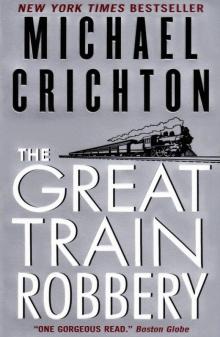 The Great Train Robbery
The Great Train Robbery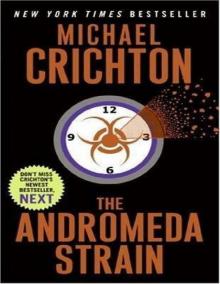 The Andromeda Strain
The Andromeda Strain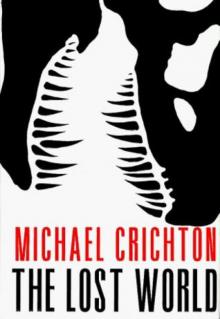 The Lost World
The Lost World Congo
Congo Travels
Travels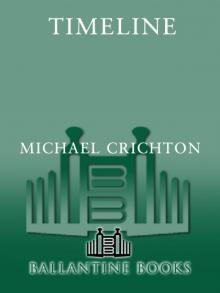 Timeline
Timeline Sphere
Sphere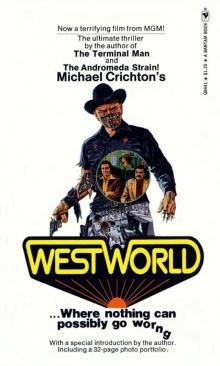 Westworld
Westworld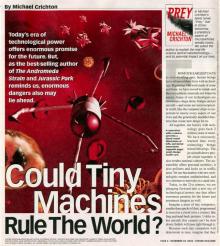 Prey
Prey State Of Fear
State Of Fear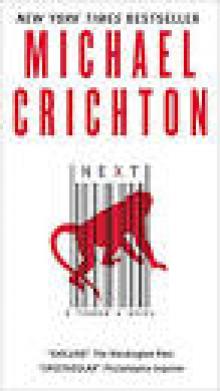 Next
Next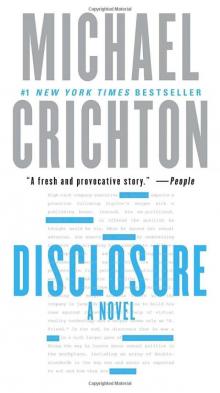 Disclosure
Disclosure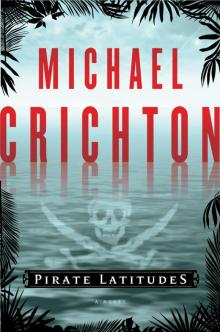 Pirate Latitudes
Pirate Latitudes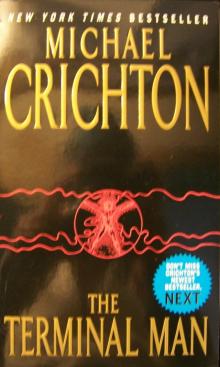 The Terminal Man
The Terminal Man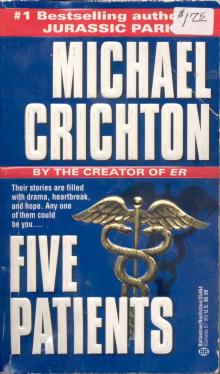 Five Patients
Five Patients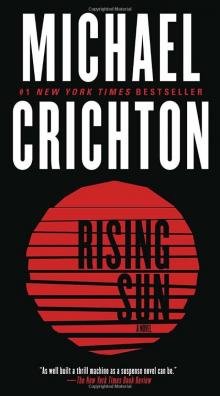 Rising Sun
Rising Sun Binary
Binary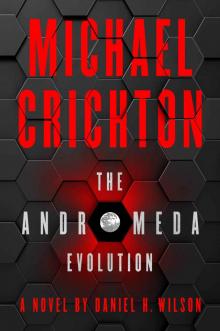 The Andromeda Evolution
The Andromeda Evolution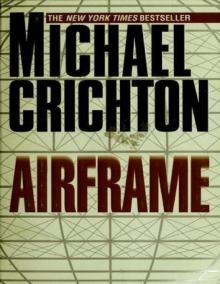 Airframe
Airframe Easy Go
Easy Go Drug of Choice
Drug of Choice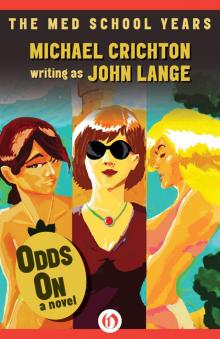 Odds On: A Novel
Odds On: A Novel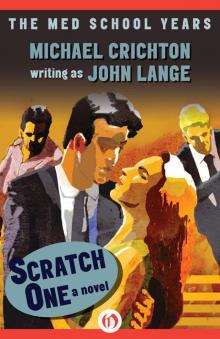 Scratch One
Scratch One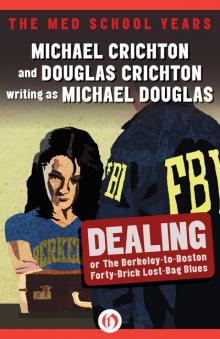 Dealing or The Berkeley-to-Boston Forty-Brick Lost-Bag Blues
Dealing or The Berkeley-to-Boston Forty-Brick Lost-Bag Blues Venom Business
Venom Business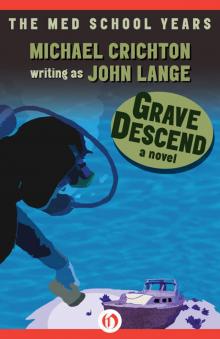 Grave Descend
Grave Descend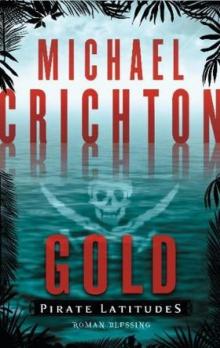 Gold - Pirate Latitudes
Gold - Pirate Latitudes Binary: A Novel
Binary: A Novel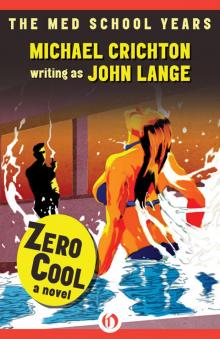 Zero Cool
Zero Cool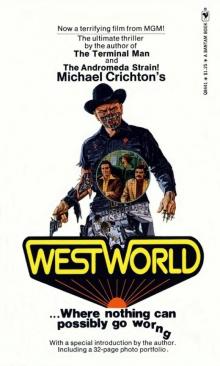 Delos 1 - Westworld
Delos 1 - Westworld